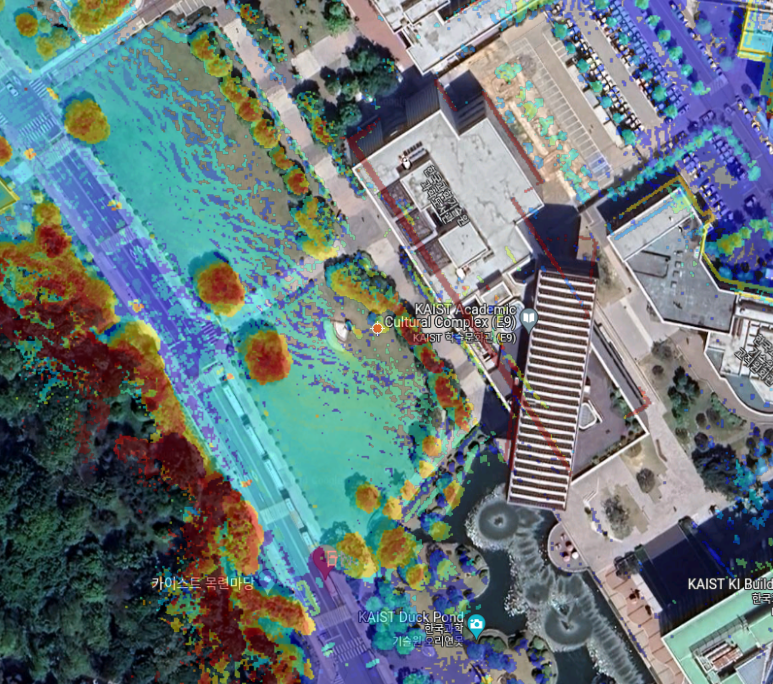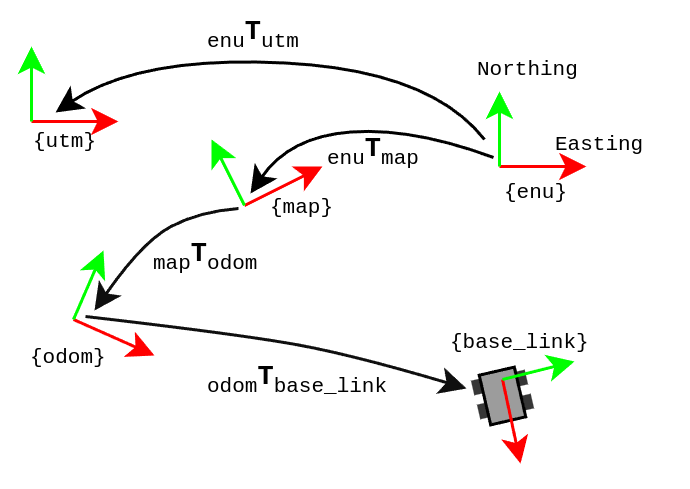Georeferencing
Georeferencing trajectories and metric maps is implemented in the mola_sm_loop_closure package.
The concept of using simple-maps as intermediary map format together with the layered metric map format (see [BC25]) enables embedding georeferenced coordinates to any kind of map typically used in robotics: grid maps, voxel maps, point clouds, etc.

1. Frames for geo-referenced maps
When working with ROS tf (transformations), MOLA packages use the following frame convention,
which extends the standard REP-105 with additional
enu and utm frames:

The existing frames are explained here.
2. How to build a georeferenced map
First, build a simple-map from a dataset or a live robot as described in Tutorial: build a map. Make sure of having a GPS (GNSS) sensor source emitting observations, and that they were captured by MOLA-LO (see the corresponding variable in the LO pipeline).
Then, build the corresponding metric map by applying a metric map generation pipeline (see [BC25]) or this step in the tutorial:
# Build metric map (mm) from simplemap (sm):
sm2mm -i datasetWithGPS.simplemap -o myMap.mm -p sm2mm_pipeline.yaml
Now, to find out the optimized map-to-ENU transformation and write it into the map file, use:
# georeference it:
mola-sm-georeferencing -i datasetWithGPS.simplemap --write-into myMap.mm
Alternatively, the georeferenciation metadata can be also stored, independently of a metric map, in an independent file with:
# georeference it:
mola-sm-georeferencing -i datasetWithGPS.simplemap --output myMap.georef
Full CLI reference
USAGE:
mola-sm-georeferencing [-v <INFO>] [-l <foobar.so>]
[--horizontality-sigma <1.0>] [-o <map.georef>]
[--write-into <map.mm>] -i <map.simplemap> [--]
[--version] [-h]
Where:
-v <INFO>, --verbosity <INFO>
Verbosity level: ERROR|WARN|INFO|DEBUG (Default: INFO)
-l <foobar.so>, --load-plugins <foobar.so>
One or more (comma separated) *.so files to load as plugins, e.g.
defining new CMetricMap classes
--horizontality-sigma <1.0>
For short trajectories (not >10x the GPS uncertainty), this helps to
avoid degeneracy.
-o <map.georef>, --output <map.georef>
Write the obtained georeferencing metadata to a .georef file
--write-into <map.mm>
An existing .mm file in which to write the georeferencing metadata
-i <map.simplemap>, --input <map.simplemap>
(required) Input .simplemap file
--, --ignore_rest
Ignores the rest of the labeled arguments following this flag.
--version
Displays version information and exits.
-h, --help
Displays usage information and exits.
3. Georeferenced trajectories
Once you already have a trajectory file in the local map frame of reference,
for example, as generated by MOLA-LO in TUM format,
and after georeferencing the generated map as shown above,
you can use the CLI tool mola-trajectory-georef to convert it into geodetic coordinates,
for example in KML format suitable for visualization in Google Earth.
Full CLI reference
USAGE:
mola-trajectory-georef -o <path.kml> -t <traj.tum> [-g <map.georef>]
[-m <map.mm>] [--] [--version] [-h]
Where:
-o <path.kml>, --output <path.kml>
(required) The name of the google earth kml file to write to
-t <traj.tum>, --trajectory <traj.tum>
(required) Input .tum trajectory, in map local coordinates
-g <map.georef>, --geo-ref <map.georef>
Input .georef file with georef info
-m <map.mm>, --map <map.mm>
Input .mm map with georef info
--, --ignore_rest
Ignores the rest of the labeled arguments following this flag.
--version
Displays version information and exits.
-h, --help
Displays usage information and exits.
4. Georeferenced maps in mm-viewer
Write me!
5. View GPS readings on a georeferenced map
Once you have published a georeferenced map (via mrpt_map_server or directly from mola_lidar_odometry), you can visualize in RViz or FoxGlove the localization from the GNSS sensor and its covariance uncertainty by installing mola_gnss_to_markers and then:
ros2 launch mola_gnss_to_markers mola_gnss_to_markers_launch.py